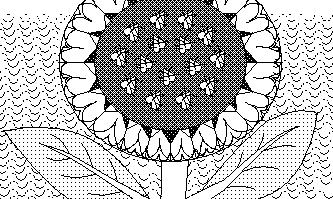Monthly Poem and Pictograph in EL, [looking into] by Fukio Shiba - August 2007 -

 .
.  .
.  .
. 
 .
. 

This is an EL (Earth Language)
experimental page to enjoy
the image of
a haiku/short poem originally
in English/Japanese.
When you can't see the Japanese parts, please
don't mind and just skip those parts
,
or see
here to view Japanese
地球語の文字や文字絵を用いて詩的表現や翻訳を試みる実験のページです。
One more time I picked haiku from "SHIKI HAIKUSPHERE."
I recently learned about a haikuist, Fukio Shiba through the introduction
by a member of
SHIKI team, Kimiyo Tanaka in this book. Fikio lived only 26 years, born
in 1903
in a small town in Ehime, Japan. Since he left lovely haiku, the local
people still love his haiku,
annually holding his memorial haiku event in that prefecture, and keeping
his home
as the museum relating to him and his works. Through
one of his relative's HP,
you can see
some photos of Fukio Shiba, although the writings are in Japanese.
Probably most Japanese associate August with sunflowers. A moment before
the Hiroshima bomb,
large fine sunflowers were open in the blue sky, although Fukio didn't
know this hard era yet.
This haiku is interesting by zooming in the view; also suggesting in
the two ways, I feel:
1) focusing something makes you forget about wider vision
2) concentrate on the heart of nature, so you can be in nature without
minding where your background is.
今月もう一度「SHIKI HAIKUSPHERE」から引用させていただきます。
この本の中でシキ・チームの田中喜美代さんが紹介されている芝不器男
(結婚後の本名:太宰不器男1903-1930)の1句です。
彼は1903年に愛媛県松野町の養蚕農家に生まれ、才能を惜しまれながらたった26年で夭折した俳人。
彼の俳句は慕われ、現在も松野町では毎年命日に「不器男忌俳句大会」が行われ、
生家も記念館として保存されていると、私ははじめて知りました。
(写真と略歴が
、彼の親戚でペンネーム:不器男さんのウェブサイト
にあります。)
芝不器男はまだ原爆の存在を知りませんでしたが、私たち世代には8月といえば原爆、
そしてその直前に広島で咲き誇っていたヒマワリが浮かぶのではないでしょうか。
この俳句は単純にカメラのような眼で詠みながら、2つの方向に示唆を与えている気がします:
1)的を絞ると、周囲が見えなり周囲とのバランスが崩れるかもしれない。
2)自然物の中心に心を集中するとき、背景は消えて、焦点の場所から深くものに入り込める。
 Original
Japanese haiku by Fukio Shiba:
Original
Japanese haiku by Fukio Shiba:
向日葵の蕊(しべ)を見るとき海消えし
The English translation by Kimiyo Tanaka:
looking into
the sunflower's center
the sea has disappeared
The EL translation:











The symbols in the pictograph:
 {
{ flower
flower  sheet}:
petal (花弁)
sheet}:
petal (花弁)
 {
{ ,
,  line/cord,
line/cord,  in/female}:
pistil (めしべ)
in/female}:
pistil (めしべ)
 {
{ ,
,  line,
line,  out/male}:
stamen (おしべ)
out/male}:
stamen (おしべ)
 : wave (波)
: wave (波)
 {
{ ,
, }(as a picture-like
symbol): leaf (葉)
}(as a picture-like
symbol): leaf (葉)
The symbols in the EL translation:
 {
{ time,
time,  preposition-mark}: at (for 'time'), when (as a relative adverb) (~のときに/の)
preposition-mark}: at (for 'time'), when (as a relative adverb) (~のときに/の)
 {
{ eye,
eye, heading to}: gazing (見つめる状態)
heading to}: gazing (見つめる状態)
 : the indicator to show that the following character or phrase is an accusative case of a
verb (~を)
: the indicator to show that the following character or phrase is an accusative case of a
verb (~を)
 {
{ {
{ plant,
plant,  heart} flower,
heart} flower,  line}: both pistil and stamen (しべ)
line}: both pistil and stamen (しべ)
* The original haiku uses this concept in Japanese for "center" in the English
translation.
 : preposition
mark; to show that the following word(s) modifies the front word(s)/phrase
or the predicate of the sentence.
: preposition
mark; to show that the following word(s) modifies the front word(s)/phrase
or the predicate of the sentence.
(後ろから前をまたは離れて後に来る述語を修飾することを示す前置符)
 { classification bracket,
{ classification bracket,
 {heart, plant}
flower}:
to show the following symbol(s) is a name of flower
{heart, plant}
flower}:
to show the following symbol(s) is a name of flower
(次の文字が花の名の表意であることを示す)
 {
{ globe,
globe,  expanded
energy}: the sun (太陽)
expanded
energy}: the sun (太陽)

 : sunflower (ひまわり)
: sunflower (ひまわり)
 (nominative indicator):
to show that the following character or phrase is the subject of a sentence,
(nominative indicator):
to show that the following character or phrase is the subject of a sentence,
when that is not at the top of a sentence.
(主語が文頭でない場合、主語の前に置いて主語を示す)
 {
{ place,
place,  wave} (the place always
with waves): the sea, ocean (海)
wave} (the place always
with waves): the sea, ocean (海)
 : grammatical notation
to form a d-verb: meaning that the subject becomes in the condition
shown by the following character/phrase; or the subject does the following
action.
: grammatical notation
to form a d-verb: meaning that the subject becomes in the condition
shown by the following character/phrase; or the subject does the following
action.
(主語が、この後続語の状態になるという意味で動詞を構成する動詞符)
 {
{ not/denied,
not/denied, shape}: invisible
(無形)
shape}: invisible
(無形)

 : disappear (vi. )(姿が消える)
: disappear (vi. )(姿が消える)
to the top
 Original
Japanese haiku by Fukio Shiba:
Original
Japanese haiku by Fukio Shiba:





 sheet}:
petal (花弁)
sheet}:
petal (花弁)  {
{ in/female}:
pistil (めしべ)
in/female}:
pistil (めしべ) {
{ out/male}:
stamen (おしべ)
out/male}:
stamen (おしべ) : wave (波)
: wave (波) ,
, }(as a picture-like
symbol): leaf (葉)
}(as a picture-like
symbol): leaf (葉) time,
time,  heading to}: gazing (見つめる状態)
heading to}: gazing (見つめる状態) : the indicator to show that the following character or phrase is an accusative case of a
verb (~を)
: the indicator to show that the following character or phrase is an accusative case of a
verb (~を) {
{ plant,
plant,  heart} flower,
heart} flower,  : preposition
mark; to show that the following word(s) modifies the front word(s)/phrase
or the predicate of the sentence.
: preposition
mark; to show that the following word(s) modifies the front word(s)/phrase
or the predicate of the sentence. { classification bracket,
{ classification bracket,
 globe,
globe, 
 (nominative indicator):
to show that the following character or phrase is the subject of a sentence,
(nominative indicator):
to show that the following character or phrase is the subject of a sentence,
 place,
place,  wave} (the place always
with waves): the sea, ocean (海)
wave} (the place always
with waves): the sea, ocean (海) : grammatical notation
to form a d-verb: meaning that the subject becomes in the condition
shown by the following character/phrase; or the subject does the following
action.
: grammatical notation
to form a d-verb: meaning that the subject becomes in the condition
shown by the following character/phrase; or the subject does the following
action. not/denied,
not/denied, shape}: invisible
(無形)
shape}: invisible
(無形)